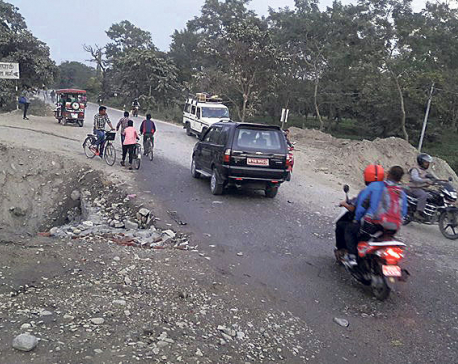
OR
Hurry up
Published On: September 13, 2017 02:00 AM NPT
Valley waste disposal
Okharpauwa of Nuwakot district bordering Kathmandu Valley has become synonymous with waste. It is the dumping ground for over 300 metric tons of solid waste that the valley generates every single day. It is a lot of waste for such a small place. Initially, the plan was to use the Sisdole landfill site in Okharpauwa for two years, after which the landfill would be shifted to Banchare Danda, in the same district, a site that is apparently capable of absorbing all the waste of Kathmandu for another five decades. But we are not sure dumping all of our waste in open landfills is the best way to deal with Kathmandu’s waste problems. First, not enough solid waste in Kathmandu is “reduced”, “reused” or “recycled”, the three best methods of waste management. The total amount of waste can be substantially reduced through wise consumption. But there is little awareness on such wise consumption. Likewise, there is next to no awareness on the segregation of the waste into its organic and inorganic components, as organic waste can often be converted into useful fertilizers. Even in the case of inorganic waste, things like glass, paper and metals can be recycled.
Similarly, it is possible to reuse glass bottles of, say, ketchup and milk. Of late a nascent art scene has evolved in Kathmandu, and all kinds of artistic reuse of waste material like discarded plastic bottles and beer cans are being made. Perhaps such cottage industries can be promoted with tax incentives. But in the larger picture, we also need a better waste disposal system. The locals of Okharpauwa have many gripes, and which is also why they time and again obstruct waste disposal, because the landfill site at Sisdole does not follow sanitary landfill protocol. People there are coming down with all kinds of diseases; the children and the elderly are especially vulnerable. The disposed waste is not decomposing fast enough, nor are there enough layers of protection that prevents dangerous chemicals from seeping into local groundwater and waterways. Thankfully, the Investment Board of Nepal is in the final phase of signing a Project Development Agreement (PDA) for its Integrated Solid Waste Management (ISWM) Project, which includes the sustainable waste disposal methods discussed above.
In the first package under the project, Nepwaste, a Nepal-Finland joint venture, will take over waste management responsibilities of Kathmandu metropolitan city and nine municipalities of Kathmandu district. In the second package, Clean Valley, a Nepal-India joint venture, will take care of the waste of Lalitpur, Bhatakpur and Kirtipur municipality. These companies will collect waste and transport it to Banchare Danda. There, separate plants will be built to generate compressed natural gas, electricity and chemical fertilizers from the waste. This is exactly the kind of solution that the valley needs. Yet it may be delayed, as Banchare Danda does not seem ready to start receiving waste immediately. But as waste has started piling up on Kathmandu’s streets, after yet another blockade of garbage-bearing trucks at Okharpauwa, people are clamoring for sustainable solutions to the valley’s waste woes. If they are incapable of dealing with this issue of urgent public interest, our newly-elected mayors and deputy mayors have no right to hold on to their jobs.
You May Like This

Candidates hurry up for poll nomination immediately after Tihar
KHOTANG, Oct 23: As the Election Commission (EC) had set October 22, the day after Bhaitika, as the date for filing... Read More...

Hurry up
After the April 2015 earthquakes, the home ministry had labeled 475 settlements across 18 districts landslide-prone during the monsoons. After... Read More...

Road department not in hurry to fix accident-prone highway section
JHAPA, Nov 30: An accident prone section of the east west highway has not been repaired even though it has claimed... Read More...





Just In
- Kushal Dixit selected for London Marathon
- Nepal faces Hong Kong today for ACC Emerging Teams Asia Cup
- 286 new industries registered in Nepal in first nine months of current FY, attracting Rs 165 billion investment
- UML's National Convention Representatives Council meeting today
- Gandaki Province CM assigns ministerial portfolios to Hari Bahadur Chuman and Deepak Manange
- 352 climbers obtain permits to ascend Mount Everest this season
- 16 candidates shortlisted for CEO position at Nepal Tourism Board
- WB to take financial management lead for proposed Upper Arun Project






_20220508065243.jpg)







Leave A Comment